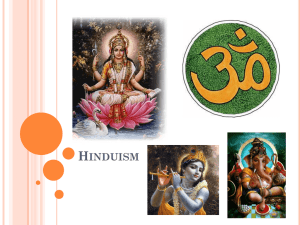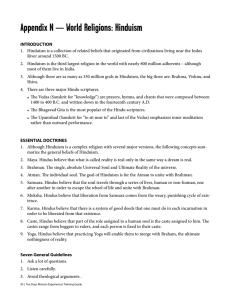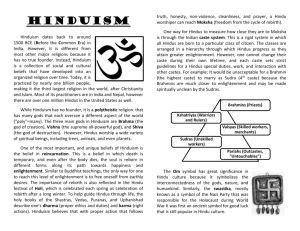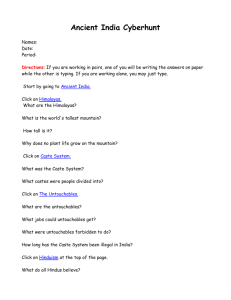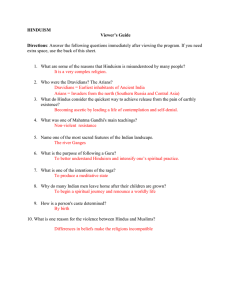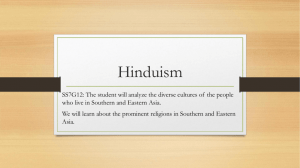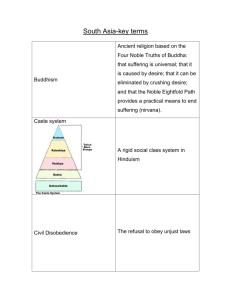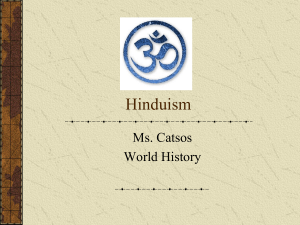About Hinduism
advertisement
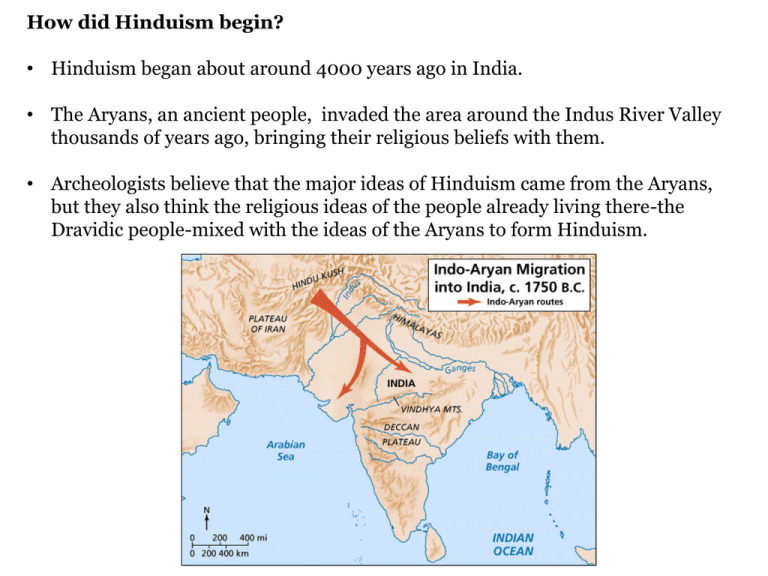
How did Hinduism begin? • Hinduism began about around 4000 years ago in India. • The Aryans, an ancient people, invaded the area around the Indus River Valley thousands of years ago, bringing their religious beliefs with them. • Archeologists believe that the major ideas of Hinduism came from the Aryans, but they also think the religious ideas of the people already living there-the Dravidic people-mixed with the ideas of the Aryans to form Hinduism. • Archeological evidence from the Indus Valley civilization of northwestern India helps to establish Hinduism as the world's oldest living religion. • Today, worldwide, there are almost one billion people who follow the beliefs of Hinduism. • Most of them live in India. Places Where Large Numbers of Hindus Live Today Holy Scripture: • Hymns, rituals and religious thought are contained in The Vedas, the very oldest scriptures of Hinduism. The very last part of The Vedas is called The Upanishads. • The Upanishads contain the fundamental teachings of Hinduism. There are stories and parables told by gurus (teachers) to their students. • The Mahabharata is an epic poem telling of a war between two royal families. This masterpiece has many parts, all of which teach important truths of Hinduism. The Bhagavad Gita is a very popular part of this text. What do Hindus believe and practice? • The fundamental teaching of Hinduism is that everyone has the spark of God within the soul. Hindus believe this spirit is within us and also within everything we see. We just have to learn to see it. • For them, the ultimate goal is to see God in everything and to feel one with God. They believe this takes years of practice. They devote themselves to spiritual training which take several forms, but it is called yoga. Jnana Yoga: the path of wisdom and knowledge, requires study and deep thinking Bhakti Yoga: involves spiritual devotion and worship of God Karma Yoga: a way of thinking and acting where you don’t consider yourself or your needs; you put aside your selfish desires and serve others Raja Yoga: emphasizes meditation; one learns to quiet and conquer one’s mind Other important teachings: • Karma-Hindus believe we are responsible for the results of our actions. The deeds we do, either bad or good, have consequences. We will be rewarded for our good deeds and punished for our bad deeds. If we don’t get rewarded or punished in this life, it will happen in the next. • Reincarnation-Hindus believe that when a person dies, his or her soul will return to the Earth in a new body. They believe that it takes many cycles of life until a human being has learned all the lessons God has to teach him or her. Rebirth in a new body is called reincarnation. • Samsara-The cycle of birth, life, death and reincarnation is called samsara. • Moksha-Liberation from samsara—no more reincarnation. This is the goal all Hindus strive for: complete union with God. What do Hindus think about God? • The general name for God in Hinduism is Brahman. • The name of the spark of divine inside us is Atman. Atman is what you might think of as your soul. • Hindus don’t think of Brahman like a person. Brahman is just “the holy.” No form, no gender, just spirit. • Just like a man can be “father”, “son”, “friend”, or “husband” but still be the same being, Hindus believe Brahman can take several forms. • Brahman in each of these forms takes a different name and has unique traits. • To people who are monotheistic, like Christians, Jews and Muslims, this seems hard to understand. This is the Hindu symbol “om”. It is placed at the beginning of most Hindu texts. It is to be pronounced at the beginning and end of a reading of from the Vedas, before any prayer and sometimes during meditation. Various Forms of Brahman: • • • • • Shiva represents the aspect of God that destroys and rebuilds. Vishnu is seen as the aspect of God who creates and sustains. Brahma is seen as the father of humanity. Shakti is seen as the mother of humanity. Krishna and Rama are both believed to be avatars-Brahman in human form. There are as many views of Brahman as there are humans on Earth, so there are thousands of Hindu “gods.” Since all the forms are Brahman who is being looked at in different ways, all these versions can be prayed to for help and protection. Shiva Vishnu Brahma Shakti What code of behavior do Hindus follow? --A Hindu’s role in life is called his dharma. One’s role is determined by the social class into which one is born and the duties associated with it. The higher your social class (or caste), the more status and power you have in society. --You must marry someone from your own caste. Most Hindu marriages are arranged by their parents. --There are four main castes in India: • Brahmins (priests and teachers) • Kshatriyas (rulers and soldiers) • Vaishyas (merchants) • Shudras (workers). Dalit Homes • Dalit (people with no caste) There is a group below the shudras called the “untouchables.” Those people were historically given the least opportunity and the most difficult and unpleasant jobs. Many of the poorest, least educated people in India today still come from this group. Caste Continued… • You cannot change your caste by working hard or marrying someone of another caste. Hindus believe that the only way you move up the social scale is by performing a lot of good karma. Then in the next life, you will move up the scale. • If you are a member of a lower caste, many Hindus believe that your low status is punishment for bad karma from a previous life. • Today in India it is illegal to discriminate against someone or refuse to hire them based on their caste, but there is still a huge gap in how people think and what the law says. Caste Continued… • The idea of caste is controversial today. • In the past, many Hindus thought of it as a positive thing. Everyone in society had a role to play. Everyone knew what their roles were. • Today India is the world’s largest democracy. How might the caste system clash with the ideals of a democratic society? Where do Hindus worship? • A Hindu place of worship is called a mandir or temple. • A temple can be dedicated to a particular god or goddess (deity). • The temple is the god's home on earth. The outside of a mandir. (This one is really fancy. They don’t all look like this!) Inside a mandir. There is no set schedule for visits to a temple. Worshippers go when they want. When entering a temple, visitors must take off their shoes and women cover their heads to show respect. How do Hindus worship? • The ceremony is called a puja. • It includes prayer and a viewing of the statue of the god or goddess honored. • Offerings of fruit, flowers and incense are made to a priest who presents them to the deity. • After the deity blesses the gifts, they are returned to the worshipper and their heads are marked with a red dot or blessing called a tilaka. • Worshippers then circle the inner shrine with their right hand raised in respect to the deity. Puja Continued… • It is also very common for Hindus to worship at a home shrine, often as a whole family. • There might be a statue or just a picture of the god or goddess. Hinduism and the Ganges River • The Ganges River is a very sacred place to Hindus. • It is a place to go on pilgrimage to bathe in sacred waters. • Hindus also like to have their ashes scattered in the Ganges after cremation. Hindu Festivals There are two main yearly festivals. All major festival celebrations include visiting a temple, eating special foods and exchanging gifts. Diwali is the festival of lights. Light represents knowledge. It is celebrated in late October or early November. This is the Hindu New Year. Holi is the festival which marks the coming of spring. It is held in March or April. There are processions and people light bonfires and cover each other with colored water and powders.

